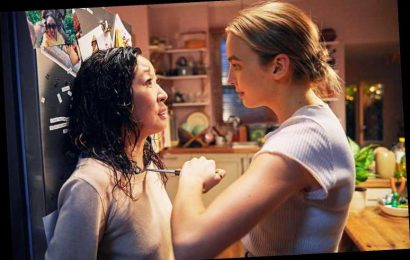Before we’re even out of the opening credits of “The Map of Tiny Perfect Things,” director Ian Samuels and screenwriter Lev Grossman waste no time clueing us into its premise revolving around a time loop that will teach its teen protagonists to accept life’s little gifts and major detours. This John Green-lite fantasy for the young-adult crowd holds many sequences that sparkle and shine, but a few that stumble and sag as well. Yet the feature’s genteel, sweet spirit and radiant lead performances rescue it from forgettable mediocrity and genre familiarity.
Seventeen-year-old budding artist Mark (Kyle Allen) begins all his mundane mornings the same way — not by choice, but because he’s trapped in a time loop. Every day he wakes up at the same exact time, sees his workaholic mom drive away, greets his dad Daniel (Josh Hamilton) and irascible younger sister Emma (Cleo Fraser) at the breakfast table, and bikes to school. He’s content with these never-ending daily do-overs, as illustrated by the playful ways he interacts with people on his trek to campus: tossing a jogger a juice box, weaving though traffic with ease and delight, giving directions to a lost passerby and helping a woman avoid embarrassment by adjusting her skirt with tongs. They’re not all acts of kindness, though. His impish Ferris Bueller-esque shenanigans also lead him to steal construction equipment, win the lotto jackpot and laugh at others’ small misfortunes.
Mark’s lonely world turns topsy-turvy once he notices Margaret (Kathryn Newton) at the community pool when she steals one of his routine moves, rescuing a swimmer from getting hit in the face. This mysterious new potential paramour is, at first, calculating and standoffish, evading Mark’s search efforts. He eventually runs into her, and she confesses she’s caught in the same temporal anomaly, endlessly searching for answers.
After they debate theories as to why this could’ve happened, the pair come up with a plan to chart all the innocuously wholesome and heartwarming moments around town. They surmise these are clues leading to a grander revelation from the universe that will enable them to break free from their unchanging reality. But as the two map the townsfolk’s triumphs (which range from a janitor playing an audience-free piano concerto to bikers who stop traffic for a turtle crossing), they fall in love, and matters become complicated.
One of the film’s strengths is how Samuels shows his protagonists whimsically engaging with the reality of their situation and environment. There are a few captivating continuous shots where it’s not simply a matter of the actors hitting their precisely choreographed marks, but also dependent on the craftspeople hitting their stride. Two of these shots appear back-to-back and work in perfect dramatic symbiosis, as the focus of a conversation shifts from Mark to Margaret. It’s a beautiful, rapturous dance that Samuels conducts between those in front of and behind the camera, augmenting the underlying notion that time is still fluid even in the loop. These long takes are used less as a highly-stylized, distracting gimmick and more as an adroit storytelling tool.
Other shrewd aesthetic choices are peppered throughout to bolster the fantastical elements. Samuels visually contextualizes the resetting of time as it warps like a malfunctioning tape in a VHS player. Cinematographer Andrew Wehde’s cool cyan color palette heightens the pull of the narrative’s grounded, emotionally evocative qualities. These are also reflected subtly not only in Kara Lindstrom’s production design, but also in Mark and Margaret’s wardrobe as a way to further tie the two together.
The other part of the fantastical feature’s magic is found in the pairing of Allen and Newton. Their witty repartee is charming and endearing, which helps counterbalance some of the more cutesy scenarios like biking through an empty high school with arms outstretched, or singing along to cheesy pop songs in a stolen vehicle. The dynamic duo’s conversations walking through town and getting to know each other feel Linklater-inspired, though the filmmakers never really tip their caps with a specific homage. Both Allen and Newton are humorous when flirty, but also infuse their work with a notable sense of depth and dimension. So when their characters’ struggles occur (like his understated resentment towards his father, and her search for a lost dog — a symbol for hope), their range as performers surfaces. Allen also has great chemistry with his look-alike on-screen father Hamilton, demonstrated in the delicate intricacies of their tenuous father-son relationship.
Unfortunately, there are a few blemishes. The Big Romantic Gesture in act two, when Mark presents Margaret with his handmade trip to the moon experience in the school gym, drags rather than soars. Repetitious scenes between Mark and his best friend Henry (Jermaine Harris) aren’t as potent or meaningful as the filmmakers hope, breaking up the picture’s energy. Henry’s at least given somewhat of a journey, but one that’s tangential and depends on two white people for a breakthrough. The mystery surrounding Margaret’s nightly phone calls from a handsome doctor is stretched out, leading us to logically guess the reasons for the call and the loop before they’re divulged. While there’s a clever twist in the reveal, which refocuses the narrative’s scope in an innovative way, its predictability blunts its emotional impact.
Sure, “Groundhog Day,” “Edge of Tomorrow,” “Happy Death Day,” “Palm Springs” and other films that express similar existential quandaries are available to this savvy audience. And yes, it may seem like our own days have all felt the same during the pandemic. But thanks to its likable leads and resonant sentiments, “The Map of Tiny Perfect Things” is a welcome break from the norm as it manages to carve out its own appealing niche in the déjà-vu subgenre.
Source: Read Full Article







